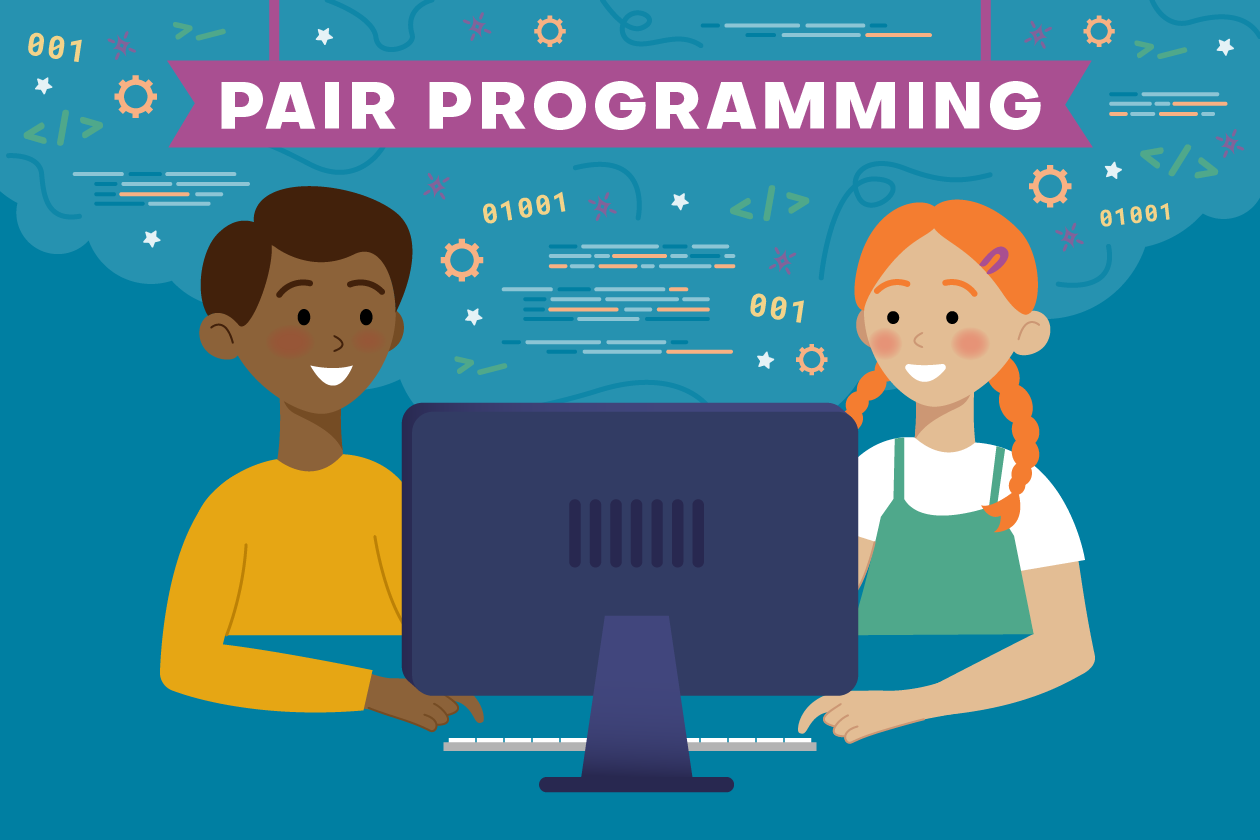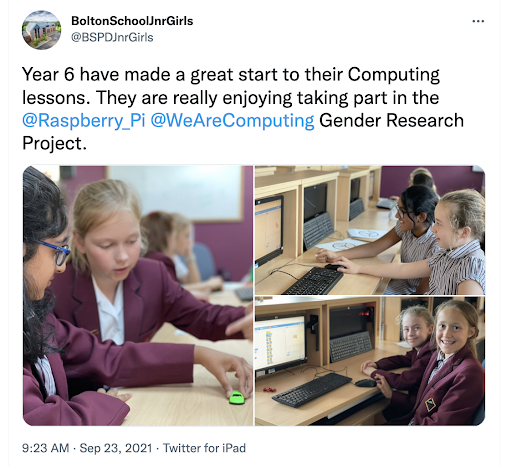Gender Balance in Computing: Trialling a pair programming teaching approach in primary computing lessons
07 July 2022

Our Gender Balance in Computing research programme is the largest national effort to date to explore ways to encourage more girls and young women to engage with computing. The research programme comprises a number of interventions relating to four different research areas and has been running since 2018.
Today we have published the second evaluation report in our series of findings from the research programme. The evaluation report shares the results of the Pair Programming intervention, which explored whether using a teaching approach called pair programming has a positive impact on girls' attitudes towards computing and their intention to study the subject in the future. The intervention involved 97 primary schools in England, and ran from September to December 2021 in Year 4 and Year 6 classes.
What is pair programming?
Paired work is often used in primary settings to support learning and develop understanding through discussion and collaborative work. For example, the Think-Pair-Share strategy involves pupils pairing up with a partner to discuss the answer to an open-ended question[1]. In computing education, pair programming is a very structured, collaborative approach to working on computer programming tasks, in which pupils work in pairs and take turns to fulfil the roles of ‘driver’ and ‘navigator’.
For this research project, we defined pair programming as follows:
Pupils work in predefined pairs, taking turns to be the driver and the navigator. The driver controls the keyboard and mouse and types in the code. The navigator reads the instructions, supports the driver by watching out for errors in the code, and thinks strategically about next steps and solutions to problems. Pupils should swap roles regularly (every 5 to 10 minutes), to ensure that everyone is contributing equally and actively to the collaborative learning.
A key part of the project was supporting teachers and pupils to identify best practice in pair programming work, reflect on how well pair programming was working in their classroom, and identify opportunities to improve collaboration. This support was embedded in both the training and the teaching resources that we provided, so that effective pair programming work became as integral to learning as the computing concepts that were being taught.
Previous research suggests that collaborative learning is particularly engaging for girls[2], whilst having no negative impact on boys[3]. However, much of the existing research has been carried out with university students[4], and there are gaps in what is known about the impact of pair programming on primary-aged girls’ engagement with computing. One previous study found that in after-school and summer programme activities, middle school girls (aged 10 to 14) were more persistent in problem-solving when using a pair programming approach[5]. Our intervention was designed to build on this study and explore whether using a collaborative, structured approach in a formal learning environment would have a positive impact on girls’ self-reported attitudes towards computing.
Working collaboratively with teachers
The first stage of the research project involved close collaboration with a small group of primary teachers, who provided feedback and input on the development of the resources that were used in the second part of the project. We value the input of classroom practitioners and are very grateful to all the schools who supported this co-production model. Whilst we didn’t purposefully evaluate the resources that were created, teachers who took part in the second stage of the project reported that they were good quality. This suggests that involving teachers in the creation of resources for research projects that will be delivered by other teachers is an effective approach that could be used again in the future.
In pair programming, it is important to pair pupils so they can work together effectively. We guided teachers to consider similarities and differences in skills or attitudes when deciding how to pair pupils; we acknowledged that teachers knew their classes best, and so were best placed to make decisions about pairings. Feedback from teachers suggested that they appreciated this approach.
“I thought very carefully about pairing the children up from my knowledge of how they are, their current abilities, and where they had progressed to in terms of computing.”
– A Primary teacher (report, p. 30)

What we learnt from this research
The impact of the intervention was measured by comparing pupil survey data from the start and the end of the intervention, from the ‘control’ group (teaching computing lessons as usual) and the ‘treatment’ group (using the pair programming teaching approach and resources). Data collected from these surveys did not show any evidence that the pair programming approach had positively affected girls’ attitudes towards computing or their intention to study computing in the future. However, during interviews with teachers, some teachers commented that they felt that girls’ attitudes towards computing had improved as a result of the collaboration in pair programming.
The intervention produced some interesting additional findings relating to the use of pair programming in the primary classroom. One aim of the intervention was to explore whether paired work would increase girls’ confidence in computing. This quote from a teacher suggests that pair programming can achieve this:
“The pair programming definitely helps. I think it boosted their confidence. They had a partner to work with so immediately that makes it more interesting for them.”
– A Primary teacher (report, p. 44)
As well as increasing their confidence, some pupils reported being motivated and engaged to work with a partner, and talked positively about it.
“My favourite thing about the computing lesson today was working with other people. Me and Oliver were setting the code to, like, 1000 and being silly with it to see what happens. It’s really funny.”
– A Female pupil (report, p. 45)
From this research project, we conclude that pair programming is a promising pedagogy to use in primary computing lessons to boost pupils’ confidence and help pupils see the value of collaborative skills in computer programming.
Find out more about pair programming
If you’d like to try using pair programming in your classroom, you can learn more through the following free resources:
- Watch this short video of a primary teacher using the pair programming approach in a computing lesson during the first stage of this intervention.
- Read this Pedagogy Quick Read on pair programming for a summary of the approach and the research that it is based on.
- Try the free online training course on pair programming used in this intervention. This course includes links to the lesson plans that teachers used.
Future work
This is the second in our series of evaluation reports that will be published as part of the Gender Balance in Computing research programme. Research projects that are part of the programme explore different teaching approaches, the importance of relevant content, interventions in non-formal education contexts, approaches to building a sense of belonging, and the impact of school subject choice systems.
You can find the full evaluation report about the Pair Programming intervention on the Teaching Approach page.
If you would like to find out more about the research programme and be notified when we publish new findings, you can sign up to our Gender Balance in Computing newsletter.
References
- Lyman F T. The Responsive Classroom Discussion: The Inclusion of All Students. In: Anderson A S (ed.), Mainstreaming Digest. University of Maryland. 1981. pp. 109–113.
- Goode J, Estrella R, Margolis J. Lost in Translation: Gender and High School Computer Science. In: McGrath Cohoon J, Aspray W (eds.), Women and Information Technology: Research on Underrepresentation. Cambridge, MA: The MIT Press. 2006. pp. 89–114.
- Hanks B, Fitzgerald S, McCauley R, Murphy L, Zander C. Pair programming in education: a literature review. Computer Science Education, 2011, 21(2), 135–173. https://doi.org/10.1080/08993408.2011.579808.
- Werner L L, Hanks B, McDowell C. Pair-programming helps female computer science students. Journal on Educational Resources in Computing, 2004, 4(1), 4–es. https://doi.org/10.1145/1060071.1060075.
- Werner L, Denning J. Pair Programming in Middle School: What Does It Look Like? Journal of Research on Technology in Education, 2009, 42(1), 29–49. https://doi.org/10.1080/15391523.2009.10782540.